There is great value in having a solid understanding of dog facial expressions and their accompanying body language and behavior. The following are some of the more common canine communications offered by those very expressive furry faces. Keep in mind, though, that when drawing conclusions about a dog’s facial expressions, it’s important to factor in the rest of the body language in order to get the whole message.
We broke down dog expressions by their eyes, ears, mouth, and mouth muscles.
Add this lexicon of dog facial expressions to what you already know about canine body language and you may be able to qualify as an expert dog listener. It just might have a positive influence on your relationship with your own dog. It may enable you to interpret for humans who haven’t yet learned to understand what their dogs are saying. It really is quite a useful skill to have.
Dog Expressions With Their Eyes
A dog’s eyes, like a human’s, are capable of conveying a multitude of meanings and emotions. Here are common eye expressions in dogs.
Soft Eye Contact
This is a dog who is social, confident and friendly. The eyes are round or almond-shaped and soft, with the pupils dilated appropriately for available lighting (small pupils if light is bright, large if light is dim). Often accompanied by affiliative (distance decreasing) behavior such as a relaxed tail wag, and body curved or even wiggling.
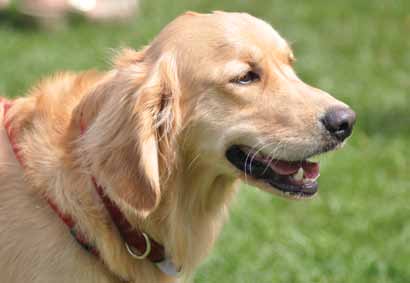
Hard Eye Contact
This is a hard, direct stare which, if you are good at reading dogs, gives you the chills. It is not friendly. The eyes are piercing, and there is often little or no body movement. Accompanying body language is usually assertive – dog is standing tall and forward, tail erect and still or wagging stiffly. This may be part of a pre-aggression “freeze” where the dog goes completely still. If this warning is ignored, the dog is likely to bite.

Squinty Eyes
This is a sign of appeasement, which is often a good thing, if it is simply the dog’s nature to be appeasing. However, appeasement can also be a signal for fear, which is not such a good thing. If the dog is squinting and approaching, it’s a friendly, social expression, and it is probably safe to interact with him. If the dog is squinting with his body posture back and lowered, it is likely fear. If you approach he may feel threatened, and bite.
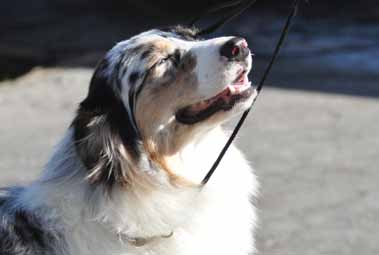
Avoiding Eye Contact
While the human species prizes direct eye contact as a measure of someone’s character and honesty, in the dog world, direct eye contact can be perceived as a threat. Often, unless a dog has been strongly reinforced for making and keeping eye contact, he will look away when you look at him. It’s a deference behavior – his way of saying he doesn’t have any desire to challenge you.
He’s doing his best to be polite and non-confrontational. Unfortunately, humans often perceive a dog as being sneaky if he won’t look them in the eye or your dog is looking sideways – a totally off-base interpretation of a very sweet canine trait. If you want your dog to make eye contact with you more, avoid body language that suggests to him he needs to defer to you, and spend lots of time reinforcing him for looking you in the eye.

Dog Whale Eye
This is a dog trainer term for when a dog shows the whites of his eyes. While it is often a warning sign and precursor to a bite, dog whale eye really just means the dog is looking sideways while his nose is pointing forward. It is often seen with resource guarding because the dog is keeping his nose pointed at the valuable resource while watching you to gauge how much of a threat you are.
Again, the rest of the dog’s body language is key to knowing when whale eye is an aggression signal and when it is not. If the body is relatively still and forward, it’s aggression. If other body signals indicate relaxation and play, then it is likely not aggression.

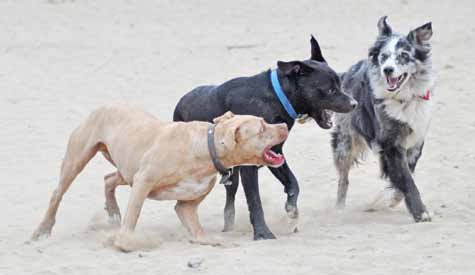
Dog Expressions With Their Ears
A dog’s ears can tell a lot about how they are feeling, but don’t forget to look at the other parts of their body to get the context of their emotional state.
Ears Pricked Hard Forward
This is a dog who is aroused and alert. The ears alone don’t tell you if it’s excited-happy-aroused/alert or aggressive-aroused/alert. If the eyes are soft and the body is wiggly, it’s the former; if the eyes are hard and the body is tense, it’s the latter.
A dog’s ears are like semaphore flags – they send clear signals to anyone who knows the code. Fortunately the dog ear code is considerably simpler than semaphore. A dog with dropped (droopy) or (heaven forbid) cropped ears can be harder to read, but the signals are still there.

Ears Relaxed
For a prick-eared dog, the ears are still up and forward, but not hard forward, and may even swivel to the side. For a drop-eared dog, the ears are hanging flat against the side of the face instead of pulled forward. Relaxed ears generally mean a relaxed dog.
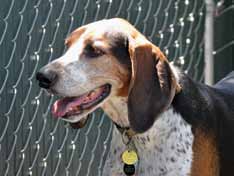
Ears Pulled Back
Regardless of ear style, ears that are pinned back against the head can mean one of several things. It can be happy appeasement, fear, or stress. As with the squinty eyes, the rest of the dog’s body language will give you clear clues as to which it is for the dog in front of you, and you can adjust your own interaction with the dog accordingly.

Dog Expressions With Their Mouth
Dogs may smile, pant, lick or show other expressions with their mouths. Looking at your dog’s mouth and facial expressions can be one of the telltale signs as to how they are feeling.
Relaxed
Your dog’s mouth, when relaxed should closed, or slightly open. If closed and relaxed, the skin around the mouth will be wrinkle-free, with possible exceptions for the wrinkly and bracycephalic (short-faced) breeds.

Tense
If your dog’s mouth is relaxed and open, and he slowly closes it, his body goes still, and there are lines around his mouth, he is not happy. Use caution, especially if his body also goes still. This is often part of the freeze sequence that is the precursor to a bite.

Open, Panting
A dog can pant for several reasons. He may have just been exerting himself, and is panting to cool off. He may be overheated, in which case emergency cooling measures are called for to prevent heat stroke or even death. Or he may be stressed. Again, evaluating the rest of his body language, as well as knowing what activities he’s been recently engaged in and taking into account the ambient temperature, will help you determine which panting is happening. Also, acute stress and distress panting is often very fast and shallow, as opposed to relaxed panting which is often slower and deeper.

Licking
Sometimes dogs lick to greet. Sometimes dogs do appeasement licking. Sometimes dogs lick their lips to get the last bits of flavor from the last tasty thing they ate. Sometimes dogs lick themselves persistently because of allergies or some other medical issue, or because of a canine compulsive disorder. And sometimes dogs lick their lips because they are stressed. Sometimes canine professionals have a tendency to overreact and call any lip-licking stress licking. It’s not necessarily. It might be. Let the rest of the dog’s body language help you decide if it is or it isn’t.
Yawning
Sometimes dogs yawn because they are tired. Sometimes dogs yawn because yawning is contagious. Sometimes dogs yawn because they are stressed. Again, look at the whole dog – and then decide.
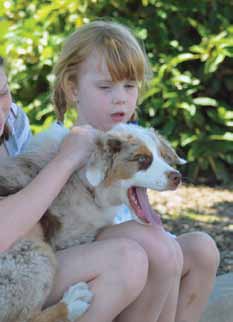
Commissure
This is just a fancy word for the corners of your dog’s mouth. Take note of how the commissure looks when your dog is calm and relaxed, and remember it for comparison purposes. There are two significant variations on the commissure. If the corners are pulled forward and the commissure forms a “C” shape, the dog is being offensively aggressive. If the corners are pulled tightly back, forming a “V” shape, the dog is being defensively aggressive. Either way, watch out!
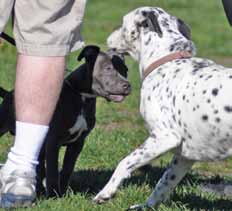
Snarl
As clumsy as some people are at reading canine body language, this one is pretty hard to miss. When the lips curl up and all those shiny white fangs are exposed, the message is usually pretty clear. The snarl is usually accompanied by very hard eyes, while the ears may be pricked hard forward or pinned back, depending on whether the dog is being offensively or defensively aggressive.
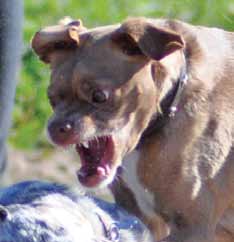
Dog Expressions With Their Facial Muscles
You probably never gave much thought to the fact that a dog’s face has muscles – but of course it does. Without them, dogs would be unable to create all the adorable facial expressions that we love so much – as well as the ones that aren’t so cute. You know what the cute ones are. There are a couple of places where facial muscles create tension lines, and these are the ones you want to watch out for.
Submissive Grin
Often mistaken for a snarl, the submissive or appeasement grin is a bit of a mystery in canine communication. It is only seen very rarely in dog-dog interactions, but is not uncommon for dogs with soft, appeasing personalities to offer to humans. One theory is that the dogs are actually mimicking human smiles! At any rate, it’s a lovely behavior that can get dogs in trouble because people think they are being aggressive when they most certainly aren’t. If you’re not sure, quickly check the rest of the dog’s body language to clues as to which it really is. I say “quickly” because if it really is a snarl, prompt evasive action may be required on your part.
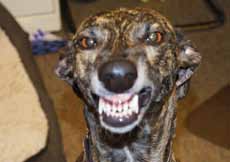
Lack of Brow Lines (calm)
A calm, relaxed dog’s brow is as smooth as a baby’s bottom (again, with those wrinkly-dog exceptions).
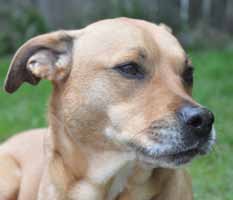
Mouth Lines
You can also see tension in the lines around your dog’s mouth. A relaxed dog’s lips are flat and wrinkle-free.
Want to learn more about the way dogs communicate and about dog body language? Check out these Whole Dog Journal sources:
1. The Meaning of Your Dog’s Vocalizations
2. Understanding Dog Appeasement Signals
3. Guide to Stress Signals in Dogs
4. How Dogs Interpret Your Body Language
5. Guide to Reading Canine Body Language
6. Dogs are Body Language Communicators
7. Listening to Your Dog’s Body Signals
Pat Miller, CBCC-KA, CPDT-KA, is WDJ’s Training Editor. She lives in Fairplay, Maryland, site of her Peaceable Paws training center, where she offers dog training classes and courses for trainers. Pat is also author of many books on positive training.



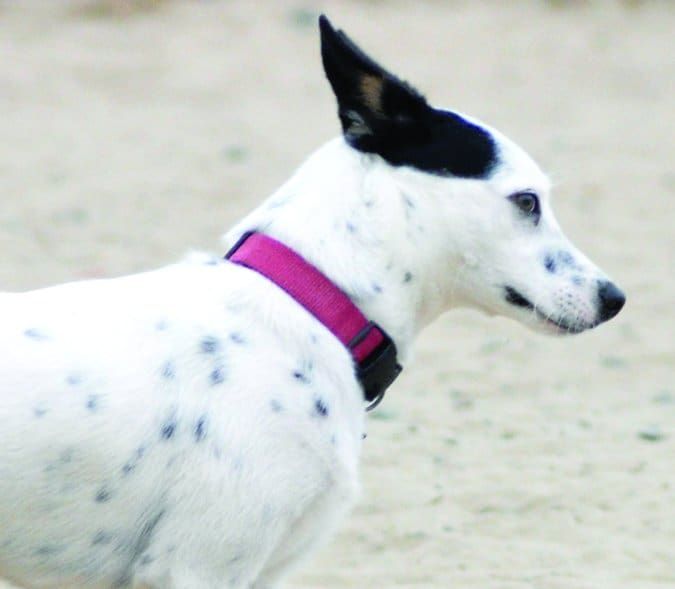
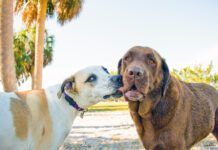
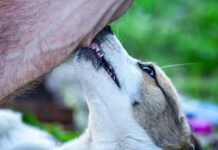
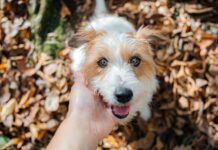
I appreciate the attempt to identify dog’s facial expressions and label them for us, however, the placement on the page is confusing, and it’s hard to tell which text refers to which photo in some cases. This is largely a formatting issues. It would help if photo captions were italicized (a standard format) and text delineated more clearly from captions, and photos placed adjacent to the thing they’re illustrating. Please fix this page! Thanks.
Thanks for putting this together it is an interesting, informative, easy read. I know I would hate to have someone post a critique with a demand like Jeanmarie’s so I apologize for her odd behavior from the rest of us readers. I appreciate the effort.
I thought it was nice of Jeanmarie to take the time to offer her (correct) editorial feedback on the placement of graphics and their captions. Her comments were simply factual, not critical, and the intent was to help. It looks like these issues have been fixed now, and the article will be more helpful to more people because of it. I like pulling together to make information about our dogs as helpful as possible — with, of course, huge thanks to Pat for her insightful and well-written pieces.
I am in a friendly argument with my cousin about how much expression can show in a dog’s face, specifically in the eyes (with surrounding structures, not just the eyeballs). Of course context and signals from the whole body are critical, but I maintain that a dog can look at her person in a soft and loving way that is NOT the same way she looks at a steak. My cousin disagrees. I would be interested to hear whether anyone has actual data on this issue (not just opinions). Have there been studies in which what the dogs are doing is known for sure (such as looking at their person vs. looking at meat), and a large number of people try to interpret the expression of the dogs in each situation?
I have found this really interesting and have learned a lot about how to read dogs. Easy to understand and useful and will recommend friends and other dog owners to read this article to have a better understanding and relationship with their best friend’s.(dogs). Thanks for the great guide
Was wondering why my dogs lower jaw smirks sometimes. Like a twitch
What kind of dog is shown with the “Lack of brow lines” caption?
It looks just like my rescue dog! I have never known what breed(s) he is. I don knows he is smart and loving though! Thanks!
What about biting one or two lips? I have a pointer that often does this?
I have a Havanese female who often gives me that full teeth smile when I’ve been playing with her. She will also make a huffing sound. I’m convinced she it imitating my smile and laugh. She will sometimes give the smile to a good friend who is petting her. People who insist that dogs don’t smile are those that have not seen a happy dog.
I didn’t see anything about ears flattened straight out to the side. That often means a dog is uncomfortable about something a dog or human is doing, although it can be a sign of submission. At least that’s what I see in my, heaven forbid, cropped Dobermans. (Yes, they can move their ears.) Oh, and I can read their docked tail signals too.
My GSD is really good at two of these…whale eye, and submissive grin. He uses these on mainly ME, when I’m playing with him, but if anyone says the word “tickle” they get the same thing. I call the whale eye his “side eye”… and the grin his “ugly face”. I get these when I tell him to do something he doesn’t want to do, too, sometimes along with a grumble. But as long as his tail is wagging and he does what he’s told, I don’t mind the grumble. That’s just his way.
Thank you for this article doesn’t say nearly enough! This is yet another excellent resource I can forward to clients and maybe even post in response to those cringeworthy “look how much my dog will tolerate from the kids” videos that make the training community gasp in fear. I have been called so many names for pointing out bites waiting to happen. Child bite prevention is one of my missions in life and resources like this are really helpful. I really hope to meet in-person one day, Pat:-) Click/treat to you and everyone at WDJ:-)